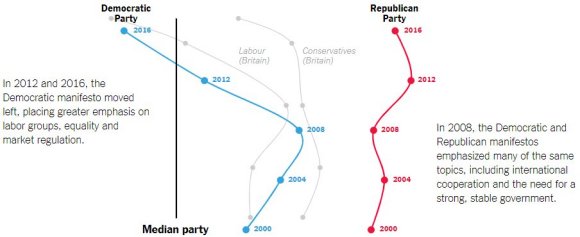The New York Times has published an article, with lovely graphics, explaining that the GOP is now an extreme right-wing party, while the Democrats — whose presidential candidates were on stage tonight calling for, among other things, abolishing private healthcare, stripping and redistributing legally earned wealth that they believe to be “in the wrong hands”, removing all legal penalties for entering the country illegally, crushing right-to-life dissenters with Federal law, and requiring Federal funding for pregnant men to abort their babies — are pretty much middle-of-the-road. Here’s the lede:
The Republican Party leans much farther right than most traditional conservative parties in Western Europe and Canada, according to an analysis of their election manifestos. It is more extreme than Britain’s Independence Party and France’s National Rally (formerly the National Front), which some consider far-right populist parties. The Democratic Party, in contrast, is positioned closer to mainstream liberal parties.
So: the Democrat platform, apparently, sits in about the same place as the median of the “manifestos” of European parties. (Why that is a good thing, given the history and current state of Europe, or why it should matter at all to Americans, is not made clear.) The article continues:
According to its 2016 manifesto, the Republican Party lies far from the Conservative Party in Britain and the Christian Democratic Union in Germany ”” mainstream right-leaning parties…
To call Britain’s Conservative Party “right-leaning”, as it waddles steadily leftward, should tell you all you need to know (or already knew) about the viewpoint from which this article originated. But then there’s this:
[T]he United States’ political center of gravity is to the right of other countries’, partly because of the lack of a serious left-wing party. Between 2000 and 2012, the Democratic manifestos were to the right of the median party platform. The party has moved left but is still much closer to the center than the Republicans.
The Paper Of Record then astonished even me by offering this illustration in support of their claim:

We see that the GOP has moved hardly at all, while the Democrats (and, to a lesser extent the U.K. Conservatives) have blasted off leftward like a rocket-sled to Hell.
In other words, the Republicans — who, let’s face it, have been nothing for any real conservative to get excited about for a very long time — have become a “far-right” party through mere constancy. (And isn’t this rather what we should expect from people who call themselves “conservative”? It’s as if the Times is startled to learn that anyone over here actually meant it.)
Meanwhile, what’s all this based on? How have we located this “center” that marks the rightmost frontier of acceptable opinion? There’s an illustration for that, too:

The thing speaks for itself. (Included in the scoring, too, are other dangerous “right-wing” ideas like “Constitutionalism”, “national way of life”, “free enterprise”, and “traditional morality”.)
The thrust of the article is unambiguous: pile up enough of those items in the top half of the diagram, and soon you are way, way out of line. (And the line keeps moving, so you’d better keep up.)
We can take all of this cum grano salis, of course. We haven’t learned anything about the Times that we didn’t already know. But: as even their own diagram illustrates, the GOP looks “far-right” to the Democrats of 2019 for the same reason that someone standing on the edge of a cliff looks “far-up” to someone who has just fallen off.
One Comment
The Times’ confidence in their mastery of “extreme” is equally breath taking and smug.